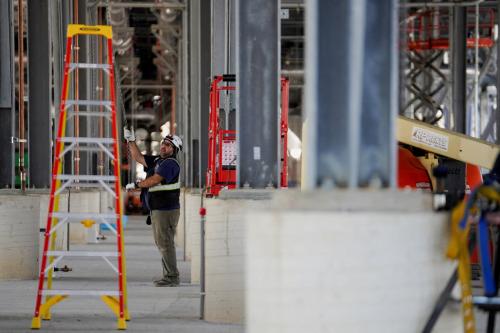The 117th Congress may be coming to an end, but its major legislation continues to reverberate.
Those laws—the American Rescue Plan Act (ARP), Infrastructure Investment and Jobs Act (IIJA), CHIPS and Science Act, and Inflation Reduction Act (IRA)—stand out for their sheer number of sizable programs, with some $3.8 trillion in total spending. But beyond this historic scale, three of the bills—ARP, IIJA, and the CHIPS and Science Act—merit special attention for another reason: the significant dollar investment they’re making into place-based industrial policy.
This moment is important. After years of growing regional divides and uneven economic progress across places, the federal government is finally experimenting with large-scale, direct investments in underdeveloped places and regions. These place-based policies also seek to advance national goals such as strengthening domestic supply chains, promoting international economic competitiveness, and mitigating the impacts of climate change.
Given that, it’s worth assessing the nearly $80 billion in place-based industrial policy passed by the 117th Congress and why, after a long time in obscurity, place-based programs are now seeing a resurgence. This analysis underscores that the nation has arrived at a significant juncture in economic policy.
What is ‘place-based industrial policy’ and why does it matter?
So, what do we mean by “place-based industrial policy”?
“Industrial policy” (or “industrial strategy”) refers to national or state efforts to encourage economic transformation through interventions in specific industries. Such programs aim to intentionally shift the economy from lower-productivity to higher-productivity activities.
For their part, “place-based” forms of such policy deliberately target interventions toward particular locations, often to advance wider interests.
Intention is what matters here. While many programs may have geographically concentrated side effects, true place-based industrial policies are consciously directed. And though such programs may aim to boost the broader economy, they do it by directly helping local economies thrive—engaging with the local needs of individuals and industries and leveraging the “bottom-up” energy of local talent, networks, clusters, institutions, and ecosystems.
As such, the success of place-based industrial policies relies on the concentrations of talent, suppliers, and knowledge that interact uniquely in a certain place to spur development. To that end, these programs’ designs must take into account the local needs of workers and communities.
For a nation with deep regional divides, place-based industrial policy is a compelling approach to economic development.
The past and present of place-based industrial policy
In the U.S., region-specific initiatives have long complemented macroeconomic policies. An early example is Alexander Hamilton’s creation of the Society for Establishing Useful Manufactures (SUM) in the 1790s. Hamilton advocated for the state of New Jersey to provide public support for SUM to develop a “national manufactory.” SUM later enacted Hamilton’s vision through the creation of a planned city named Paterson, which leveraged the water power of the nearby Great Falls while a network of factories was built around it. Later examples include the expansive geographic transformations driven by national “big pushes” such as publicly financed manufacturing plants during World War II or high-tech spending during the space race.
Such initiatives greatly enhanced regional economies for generations to come, as scholars such as Andrew Garin and Jonathan Rothbaum, Shawn Kantor and Alexander Whalley, and Daniel P. Gross and Bhaven N. Sampat have shown. Garin and Rothbaum, for example, demonstrate that WWII-era factory openings catalyzed a persistent expansion of high-wage manufacturing work in those regions, which supported permanent increases in regional employment and long-term upward mobility, with the largest effects on children of parents with lower earnings.
Today, place-based industrial policy is resurfacing after 40 years in which the federal government has been reluctant to engage with it outside of the defense sector. Part of this renewal owes to the need for extraordinary measures to rethink shaky supply chains, counter China’s rising economic power, and address the existential danger of climate change.
But beyond that, the new place-based policy push reflects the fact that a bipartisan array of stakeholders is sounding the alarm on the nation’s worsening regional divides, as many of the nation’s towns and regions struggle under the weight of economic stagnation and social decline. As such, today’s new era of place-based industrial policy seeks to both build out the nation’s technological and industrial capacity as well as push against regional inequality.
Where almost $80 billion in place-based spending is going
To assess the full array of place-based industrial policies passed by the 117th Congress, we reviewed hundreds of individual programs inside ARP, IIJA, the CHIPS and Science Act, and the IRA. We identified programs that were both industrial policy (those that seek to promote industrial transformation) and place-based (meaning that their interventions intentionally engage with local assets such as talent, clusters, or networks).[1]
Altogether, our initial count found 19 place-based industrial policy programs distributed across three of the four pieces of legislation (ARP, IIJA, and CHIPS and Science).[2] While the IRA contains significant industrial policy spending, its programs are not explicitly “place-based” as defined here.
As to their purposes, the 19 place-based programs have multiple goals, including expanding domestic semiconductor manufacturing; creating regional “innovation hubs” and “innovation engines” to advance technology development and job creation; and financing regionally driven efforts to scale emerging clean energy technologies.
Altogether, the 19 programs account for $77.4 billion in spending through 2027 and represent 2.3% of the three laws’ total cost.[3]
To put this in perspective, economist Tim Bartik has noted that the nation’s two largest, oldest place-based programs—the Tennessee Valley Authority (TVA) and the Appalachian Regional Commission (ARC)—reached maximum spending levels of $9 billion and $10 billion (in 2022 dollars), respectively, over five-year periods in the 1950s and 1960s. This suggests that the new burst of place-based industrial policy is sizable in comparison to two of the nation’s more substantial efforts of the postwar period.
The place-based programs in the three laws provide a snapshot of new directions in industrial policy, including:
- The significance of the CHIPS and Science Act. Over 77% of the funding for place-based industrial policy resides in the CHIPS and Science Act. That’s because the single-largest program we identified—the act’s centerpiece CHIPS for America Fund—accounts for over half of the place-based industrial policy funding contained within the three laws. Of the remaining funding, less than 19% is in the IIJA, and just under 4% is in ARP.
- Five programs account for 82% of spending. The five largest place-based industrial policy programs—the CHIPS for America Fund, Regional Technology and Innovation Hubs, Regional Clean Hydrogen Hubs, and the Regional Innovation Engines / Translation Accelerator (whose funding is combined in the CHIPS and Science Act)—account for 82% of the total place-based industrial policy funding across the three laws.
- Commerce plays a central role. Because of the large size of the CHIPS for America Fund, about 69% of all place-based industrial policy spending is being overseen by the Commerce Department. Nearly 97% of place-based spending is housed within Commerce, the Department of Energy, and the National Science Foundation.
- Challenge grants predominate. The vast majority of funding across these 19 programs—including nearly all of the funding not allocated to regionally focused commissions such as the ARC—will ultimately be distributed to communities via challenge grants. As noted in a recent Brookings Metro analysis of the Build Back Better Regional Better Regional Challenge, distributing funding to locations via such grants represents a powerful form of place-based investment, since the competitive nature of the award system can align local actors around a shared vision. To the extent communities or regions want to compete for these pots of federal funding, they will be well served by identifying where their existing clusters align with these opportunities, as well as by ensuring various regional actors are working cooperatively toward winning funding. Moreover, state governments may want to serve as central points on coordination to ensure their regions are proposing complementary—rather than contradictory—projects.
- Clusters are prominent. Another common characteristic across the 19 programs is the frequent emphasis on cluster strategies. For example, the CHIPS for America Fund implementation strategy notes that the program “will facilitate the expansion, creation, and coordination of semiconductor manufacturing and innovation clusters that benefit many companies.” Similarly, Carbon180’s primer on the Department of Energy’s Direct Air Capture Hubs notes, “Hubs allow projects and industries with common infrastructure needs to co-locate and collaborate in order to cluster employment opportunities, leverage economies of scale, and streamline permitting processes.” Other programs identified here reference similar cluster-based focuses.
As to the bigger picture, the 117th Congress’ place-based industrial programs reflect a growing acknowledgement that the nation’s economy is itself place-based—shaped by a network of “distinct regional economies, each with its own history and opportunities,” as two of the authors of this piece wrote recently with colleague Glencora Haskins. These programs represent an embrace of strategies that address broad problems in local ways—an important experiment in program design that holds out the possibility for a new generation of more effective and relevant public policies to address economic challenges, regional health, and economic inclusion.
Which raises a final note: Now that these programs have been authorized, what is needed is for Congress to provide full appropriations for each of them, and for agencies to effectively implement and then rigorously evaluate them to assess how well they work. In that sense, the array of place-based industrial policies represents an excellent occasion to rediscover a region-first approach to economic development, with implementation and evaluation at a new degree of scale.
End notes
[1]
Brookings’s identification process employed three steps to identify programs dedicated to place-based industrial policy within the many programs across ARP, IIJA, CHIPS and Science, and IRA. The first step was a keyword search to identify potentially relevant programs. Keywords included: “region,” “cluster,” “hub,” “economic,” and “development.” The next step was a more detailed read of both the section-by-section summaries and bill text for each program surfaced during the keyword search, to determine if they could reasonably be defined as “place-based.” One definition of “place-based” is from David Neumark and Helen Simpson: “[P]lace-based policies refer to government efforts to enhance the economic performance of an area within its jurisdiction, typically in the form of more job opportunities and higher wages.” (See David Neumark and Helen Simpson, “Place-Based Policy.” Working paper 20049. [National Bureau of Economic Research, 2014].) From there, the authors narrowed the list further by removing any programs that did not have a primary focus on either industrial cluster policy or economic development to improve the structure of the local economy. There were many programs that were place-based in nature but were not primarily focused on industrial cluster policy or economic development. One example of this is the IIJA’s Reconnecting Communities Pilot Program, which is clearly place-based, but has a primary focus on improving the built environment. While that can ultimately bolster community, economic, and regional development, the program itself doesn’t guarantee any economic development, let alone economic transformation. Rather, it sets the state up for potential future economic development.
[2]
In the CHIPS and Science Act, two programs—the National Science Foundation’s (NSF) Regional Engines program and Translation Accelerator program—are authorized under two separate bill sections. However, the two programs share a combined funding stream (and NSF is also directed to establish a regional balance between the two programs). As a result, it is impossible to fully disaggregate the funding between the two programs. In order to be as accurate as possible about relative funding sizes, this analysis combines the two programs in Table 1 and Figure 1, but treats them as separate when totaling the number of programs.
[3]
The $77.4 billion total includes programs that were authorized in the CHIPS and Science Act but have not yet been appropriated, such as the Regional Technology and Innovation Hub Program.
The Brookings Institution is committed to quality, independence, and impact.
We are supported by a diverse array of funders. In line with our values and policies, each Brookings publication represents the sole views of its author(s).









Commentary
Breaking down an $80 billion surge in place-based industrial policy
December 15, 2022